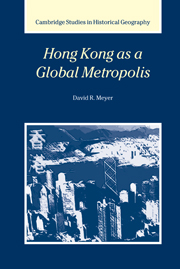Book contents
- Frontmatter
- Contents
- List of figures
- List of maps
- List of tables
- Preface
- 1 Enigma
- 2 Intermediaries of capital
- 3 From Canton to Hong Kong
- 4 Hub of the China trade
- 5 Chinese and foreign social networks of capital
- 6 Trade and finance center for Asia
- 7 Industrial metropolis
- 8 Global metropolis for Asia
- 9 Hong Kong, China
- Bibliography
- Index
- Cambridge Studies in Historical Geography
6 - Trade and finance center for Asia
Published online by Cambridge University Press: 28 July 2009
- Frontmatter
- Contents
- List of figures
- List of maps
- List of tables
- Preface
- 1 Enigma
- 2 Intermediaries of capital
- 3 From Canton to Hong Kong
- 4 Hub of the China trade
- 5 Chinese and foreign social networks of capital
- 6 Trade and finance center for Asia
- 7 Industrial metropolis
- 8 Global metropolis for Asia
- 9 Hong Kong, China
- Bibliography
- Index
- Cambridge Studies in Historical Geography
Summary
In Hong-Kong the Chinese houses are increasing annually, while the English and other foreign ones are decreasing … Nineteen-twentieths of the population of Hong-Kong are Chinese, and there is not a branch of business into which they have not entered. They have shipping and commercial houses, steam-ship, banking, and insurance companies.
Hong Kong pivot
Commodity trade
By the 1860s, visitors to Hong Kong knew they had arrived at a Chinese city, and that character continued as the Chinese proportion of the population stayed around 95 percent through the 1920s; their in-migration and natural increase powered its population growth (fig. 6.1). Because Hong Kong operated as a trade and financial center, businesses in those sectors signified its status as a metropolis. The number of non-Chinese provide a crude indicator of those workers for the foreign group. Between 1861 and 1901, that number rose almost sevenfold from about 3,000 to 20,000, and then stayed at that level until 1931 (fig. 6.1). These counts, however, overstate the actual number affiliated with trade and finance because they include dependants, government officials, and military personnel. Fewer than a third of the non-Chinese worked in foreign firms, implying that about 6,000 were employed in trade and finance by the start of the twentieth century. Nevertheless, this group mostly comprised upper-level managers and office workers because the Chinese supplied the laborers. The number of Chinese traders and financiers ranged from about 500 to 1,000 in 1871 to over 3,000 by 1881 and 1891.
- Type
- Chapter
- Information
- Hong Kong as a Global Metropolis , pp. 114 - 142Publisher: Cambridge University PressPrint publication year: 2000



